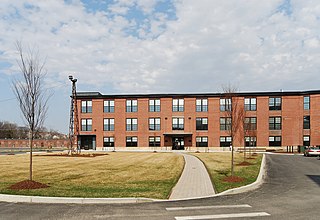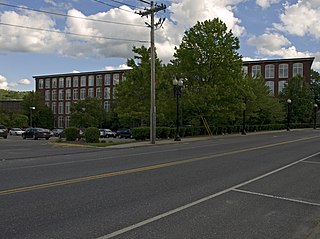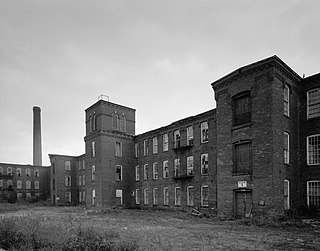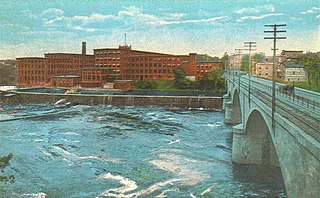
The Florence Mill, known later as the U. S. Envelope Building, is a former industrial facility located at 121 West Main Street in the Rockville section of Vernon, Connecticut. Developed in stages between 1864 and 1916, it exhibits changes in mill construction technology over that period, include a rare early example of Second Empire architecture. Now converted into senior housing, it was listed on the National Register of Historic Places in 1978.

The Saxony Mill was a historic textile mill complex at 66 West Street in Rockville section of Vernon, Connecticut. With a construction history dating to 1836, it was one of the oldest surviving wood-frame textile mills in the state prior to a 1994 fire which led to its demolition. The mill complex was added to the National Register of Historic Places in 1983.

The United States Rubber Company Mill Complex is a historic industrial facility in Providence, Rhode Island. It is a large complex of factory buildings covering about 23 acres (9.3 ha) on the north bank of the Woonasquatucket River. It is bounded on the west by Ericson Place, the north by Valley Street, and the east by Hemlock Street. The property includes 29 historic buildings, built between c. 1885 and c. 1960, as well as three bridges. The buildings are predominantly brick structures, ranging in height from one to five stories, and were built either by the Joseph Banigan Rubber Company, its successor the United States Rubber Company, or the American Locomotive Company, whose property east of the rubber works was acquired by the US Rubber Company in 1918. Only four buildings built by these companies are known to have been demolished before 1960. The plant closed in 1975, and has since been adapted to a variety of other uses.

The Farwell Mill is an historic former mill complex at 244 Lisbon Street in Lisbon, Maine. Built in 1872, it is a fine example of a cotton mill built at the height of the Industrial Revolution. It was listed on the National Register of Historic Places in 1985. It is now residential housing.

The Bigelow Carpet Mill is an historic textile mill complex at Union and High Streets in Clinton, Massachusetts. Built in 1847 and repeatedly enlarged until 1922, this large mill complex was one of the world's major early automated manufacturers of Brussels tapestry, established by Horatio and Erastus Bigelow. The mill was listed on the National Register of Historic Places in 1978.

The Hotchkissville Historic District is a historic district in the town of Hotchkissville, Connecticut adjacent to Woodbury, Connecticut that was listed on the National Register of Historic Places in 1995. It encompasses most of the historic village of Hotchkissville, which is centered at the junction of Washington and Weekeepeemee Roads. The village began as a dispersed rural agricultural community, but developed in the 19th century with the arrival of industry, primarily the manufacture of textiles. Despite this, the village has retained a significantly rural character, and includes a broad cross-section of 18th- and 19th-century architectural styles. Notable residents include the Wols family.

Mill Conversion or mill rehab is a form of adaptive reuse in which a historic mill or industrial factory building is restored or rehabilitated into another use, such as residential housing, retail shops, office, or a mix of these non-industrial elements (mixed-use).

The Algonquin Printing Co. is a historic industrial complex at 1 Middle Street, off Bay Street in Fall River, Massachusetts. Developed beginning in 1891, it was the last 19th-century printing operation to be established in the city. The surviving main building was built in 1902, and the company operated on this site until 1941. It was listed on the National Register of Historic Places in 1983.

The Berkshire Mill No. 1 is a historic mill complex on Hoosac Street in the center of Adams, Massachusetts. Built in 1895 by the locally prominent Plunkett family, it is an important surviving reminder of the town's industrial textile past. Now converted into mixed residential and commercial use, it was listed on the National Register of Historic Places in 1982.

The Johnson Manufacturing Company was a historic mill complex at 65 Brown Street in North Adams, Massachusetts. Developed beginning in 1872 and enlarged through the early 20th century, it was at the time of its 1985 listing on the National Register of Historic Places a well-preserved example of late 19th century industrial architecture, used for the production of textiles for many years. The complex was demolished in 2007.

The Renfrew Mill No. 2 was a historic mill complex at 217 Columbia Street in Adams, Massachusetts. Most of its buildings were built between 1867 and 1878, and were brick buildings with Italianate styling. They were built by the Renfrew Manufacturing Company, a textile manufacturer, to replace an earlier complex further down Columbia Street that had been demolished. The property was acquired by the Arnold Print Works in 1928. The mill was the town's largest employer for much of the second half of the 19th century.

The Andover Village Industrial District encompasses one of the 19th century industrial mill villages of Andover, Massachusetts known locally as "The Village". The growth of this village contributed to the decision in the 19th century to separate the more rural area of North Andover from the town. It is centered on a stretch of the Shawsheen River between North Main Street on the east and Moraine Street on the west. Most of the district's properties lie on Stevens Street, Red Spring Road, Shawsheen Road, and Essex Street, with a few properties also located on adjacent roads.

The Hillsborough Mills are a historic textile manufacturing complex at 37 Wilton Road in western Milford, New Hampshire, near its town line with Wilton. The oldest buildings of the brick mill complex were built in 1866 as a carpet-making operation. This business failed in 1874, but the complex was acquired by other textile interests, and eventual saw success producing carpet yarns, and blankets for horses and bedding. The mills were closed in 1970, and have since been adapted for other uses. The complex was listed on the National Register of Historic Places in 2014.

The American Woolen Company Foxcroft Mill or Mayo & Son Woolen Mill is a group of seven historic buildings and three structures on East Main Street in downtown Dover-Foxcroft, Maine. The district is located on 2.77 acres (1.12 ha). The Foxcroft Mill is located on the west side of the Piscataquis River, which flows through downtown Dover-Foxcroft. The buildings were built between 1844 and 1941, and have been listed on the National Register of Historic Places.

Washington Mills-Mayodan Plant, also known as Mayo Mills, Washington Group-Mayodan Plant, and Tultex Corp.-Mayodan Plant, was a historic textile mill and national historic district located at Mayodan, Rockingham County, North Carolina. It encompassed four contributing buildings and two contributing structures in the town of Mayodan. The main spinning mill was built in 1895, and was a three-story, rectangular brick structure with a low-pitched gable roof. The mill was expanded several times between 1897 and 1954. It featured a four-story, one bay, tower with an open belfry at the top. Also on the property were the contributing knitting mill (1911), transformer house, railroad underpass, railroad spur, and frame wood shed. The mill closed in 1999.

The Sanford Mills Historic District encompasses a large industrial complex in the center of Sanford, Maine, United States. From 1867 to 1955, the property was the site of a major textile manufacturing operation that was a major local employer. The site, flanking the Mousam River just north of Sanford's central business district, was listed on the National Register of Historic Places in 2009.

The Lockwood Mill Historic District encompasses the only major 19th-century mill complex in Waterville, Maine. Located south of the city's downtown, it was designed by Amos D. Lockwood, a nationally known industrial designer of the period. Its #2 building was for 45 years home to the Hathaway Shirt Company. It was listed on the National Register of Historic Places in 2007.

The Broad Brook Company was a manufacturer of textiles in East Windsor, Connecticut, which operated from the 1830s until 1954. The company plant, located on Broad Brook at Main Street and Scott Road in the town's Broad Brook village, was listed on the National Register of Historic Places in 1985. Partially destroyed by fire, with surviving buildings converted into residential condominiums in the 1980s, the complex has been shuttered due to the discovery of toxic soil conditions on the property.

The Jenckes Spinning Company is a historic textile factory complex in Pawtucket, Rhode Island. Located on Conant and Weeden Streets, the complex was developed between 1883 and 1919, and was home to the city's largest employer in the 1910s, producing cotton fabric and fabric for use in automotive tires until 1933. The factory complex was listed on the National Register of Historic Places in 2018.

The Home Woolen Company is a historic textile mill complex on Main Street in Beacon Falls, Connecticut. Developed between 1853 and 1916, the complex housed major local employers, engaged first in the manufacture of woolens and rubber products. The complex has been converted to residential use. It was listed on the National Register of Historic Places in 1984.





















